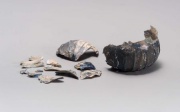Plaster of Paris
Description
A fine white powder composed a calcium sulfate hemihydrate. Plaster of Paris obtained its named because it was primarily prepared from Gypsum quarried in the Montmartre district of Paris. Gypsum, calcium sulfate dihydrate, is roasted or calcined at temperatures below 250C to drive off some of the water of crystallization. Calcium sulfate hemihydrate is stable in air, but readily combines with water to form a paste that rapidly sets to an impenetrable solid. It generates heat with setting and may expand slightly. Setting can be accelerated by the addition of small amounts of salts (Aluminum sulfate, Potassium sulfate) or retarded by the addition of organic materials (Blood, Glue, Casein). Plaster of Paris has long been used for molds, sculpture, and casts.
Synonyms and Related Terms
calcium sulfate hemihydrate; bassanite; calcined gypsum; calcined plaster; burnt gypsum; partially dehydrated gypsum; plaster; escayola (Esp.); plâtre de Paris (Fr.); Plaster of Paris, Stuckgips (Deut.)
Risks
- Ingestion may be harmful.
- Anmol Chemicals: SDS
Resources and Citations
- R. J. Gettens, G.L. Stout, Painting Materials, A Short Encyclopaedia, Dover Publications, New York, 1966
- G.S.Brady, Materials Handbook, McGraw-Hill Book Co., New York, 1971 Comment: p. 386
- Ralph Mayer, A Dictionary of Art Terms and Techniques, Harper and Row Publishers, New York, 1969 (also 1945 printing)
- Susan E. Schur, Conservation Terminology: A review of Past & Current Nomenclature of Materials, Technology and Conservation, Spring (p.34-39); Summer (p.35-38); Fall (p.25-36), 1985
- Dictionary of Building Preservation, Ward Bucher, ed., John Wiley & Sons, Inc., New York City, 1996
- Marie Svoboda, Conservation Survey Index, unpublished, 1997
- Art and Architecture Thesaurus Online, http://www.getty.edu/research/tools/vocabulary/aat/, J. Paul Getty Trust, Los Angeles, 2000
